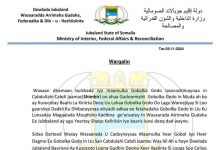
A devastating drought in Somalia has reached unprecedented levels, as the one million people have been displaced by the drought.
More than 755,000 people have been internally displaced in Somalia because of the severe drought this year, bringing the total figure to 1 million people since January 2021 when the drought began, according to displacement figures released today by UNHCR, the UN Refugee Agency, and the Norwegian Refugee Council (NRC).
“This one million milestone serves as a massive alarm bell for Somalia,” said Mohamed Abdi, NRC’s Country Director in Somalia. “Starvation is now haunting the entire country. We are seeing more and more families forced to leave everything behind because there is literally no water or food left in their villages. Aid funding urgently needs to be ramped up before it is too late.”
Somalia is witnessing a two-year historic dry spell – a situation not seen in more than 40 years – and an expected fifth failed rainy season is bound to displace many more families, as famine looms on the horizon.
Hussein, an elderly father of eight, recently arrived at a camp for displaced people with his family, having fled his village after drought ravaged their crops and livestock. “The people left behind, they have no chance,” he said. “It is just a matter of time until they die. Even here we might die because we have nothing.”
The number of people facing crisis hunger levels in Somalia is expected to rise from some 5 million to more than 7 million in the coming months, exacerbated by the effects of climate change, and rising food prices because of the conflict in Ukraine.
“Vulnerable communities are the hardest hit by the effects of the climate crisis, leaving many families unprotected and increasing displacement”,” says UNHCR’s Representative in Somalia, Magatte Guisse. “The Somalia situation was already one of the most underfunded before this latest crisis. While we and humanitarian partners are doing what we can to respond, we simply have insufficient resources. The international community must step up to save lives and support this humanitarian response.”
In June, UNHCR announced it needs US$ 9.5 million for Somalia, as part of its regional appeal for the Horn of Africa, to help displaced communities affected by the catastrophic drought.
Around 7 million people across Somalia are expected to experience high levels of acute food insecurity between now and September, including more than 213,000 facing catastrophic hunger, unless urgent support is provided.
The 2022 Gu rainy season in Somalia came to an early end in May, with lower rainfall recorded and little to no rain in June. Northern areas recorded 30 to 60 per cent of the average rainfall, while the central and southern areas received 45 to 75 per cent. This marks a fourth consecutive failed rainy season since late 2020.
Somalia is ranked second highest globally in terms of climate vulnerability, based on 2019 data, according to the University of Notre Dame’s Global Adaptation Initiative ranking.











